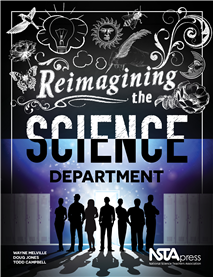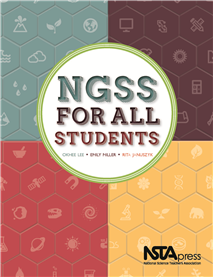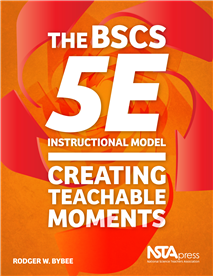All Book Chapters
Book Chapter
The purpose of this lab is for students to apply their knowledge of how chemicals, specifically carbon, cycle through the living and nonliving components of an ecosystem. Specifically, they will explore ”Which Carbon Cycle Process Affects Atmospher...
Book Chapter
The purpose of this lab is to introduce students to the variation that naturally exists within a species and among different species that are closely related. Specifically, they will explore ”How Do Beetle Traits Vary Within and Across Species?” ...
Book Chapter
The purpose of this lab is to introduce students to the transfer of genetic information through inheritance and how DNA-level mutations can influence the functions of organisms. Specifically, the investigation will allow them to use a computer simula...
Book Chapter
The purpose of this lab is for students to apply what they know about the inheritance of traits to solve a problem. Specifically, the investigation gives them an opportunity to use several conceptual models as a way to make sense of ”How Do Fruit F...
Book Chapter
The purpose of this lab is to introduce students to the basic principles of natural selection. Specifically, the investigation gives them an opportunity to use a simulation to develop an explanation of ”Why Does a Specific Version of a Trait Become...
Book Chapter
Phylogenetic Trees and the Classification of Fossils
The purpose of this lab is for students to apply what they have learned about phylogenetic trees and phylogenetic classification to determine ”How Should Biologists Classify the Seymouria?” The Teacher Notes provide the connections to standards, ...
Book Chapter
Descent With Modification and Embryonic Development
The purpose of this lab is for students to apply what they have learned about the theory of descent with modification to explain similarities in animal embryo development. The lab gives students an opportunity to use images of animal embryos to test ...
Book Chapter
In this chapter, the purpose of this Lab 18 is for students to apply what they know about migration, genetic drift, and natural selection to explain the evolution of beak size in a population of birds....
Book Chapter
The science department has existed in its current form for approximately 100 years. If, however, we believe that departments are places in which science teachers can begin to understand and challenge why they teach the way they do, and the imperative...
Book Chapter
Why Is Questioning a Powerful Teaching Tool?
Questioning cultivates student engagement and drives instruction throughout the learning process. It is a vital part of science and engineering. Questions challenge student thinking at key points within a lesson or unit of study to connect concepts a...
Book Chapter
How Do I Prepare for the Power of Questioning?
Involving students in the Powerful Practices model requires that you know your students as individuals and as a group. This will help create engaging questions and a collaborative environment that supports dynamic discussions, leading to purposeful l...
Book Chapter
How Do I Implement the Power of Questioning?
Sharing ideas with a partner or group helps students structure thoughts to communicate thinking and offers an opportunity for them to learn together. When you model metacognition and use a variety of questioning strategies, your students learn how to...
Book Chapter
Using the 5E Model to Implement the Next Generation Science Standards
This chapter provides recommendations for translating standards into instructional materials that are usable for those with the real task of teaching. The discussion provides an affirmative answer to the question: How can the BSCS 5E Instructional Mo...
Book Chapter
Why Does Skill in Questioning Engage Students in Purposeful Standards-Based Learning?
Students need to see purpose for what they are learning as they engage in literacy practices. Children ask questions and make connections to what is being learned in the classroom every day—on the playground, at home, walking to and from class, and...
Book Chapter
Teaching Science for Conceptual Understanding: An Overview
A primary goal of science education is teaching for conceptual understanding. But what does this mean? We argue that teaching for conceptual understanding can and should exist alongside the pressures of testing, “covering the curriculum,” and ins...
Book Chapter
Students With Disabilities and the Next Generation Science Standards
The Next Generation Science Standards require that students engage in science and engineering practices to develop deeper understanding of the disciplinary core ideas and crosscutting concepts. ...
Book Chapter
NGSS: Giving Every Student a Choice
The process for developing the Next Generation Science Standards (NGSS) was not a simple one. There were many decisions made that while necessary did not make the process simpler. However, one decision was never in debate—the NGSS were meant for al...
Book Chapter
This chapter serves two purposes. First, it provides a context for the work presented in A Framework for K–12 Science Education and the guiding document that underlies the Next Generation Science Standards (NGSS). Second, it discusses that scienc...
Book Chapter
On Building Policy Support for the <i>Next Generation Science Standards</i>
In this chapter, the editor discusses observations made as a foundation officer at Carnegie Corporation of New York throughout the development of the Common Core State Standards (CCSS) and the Next Generation Science Standards (NGSS). In particular,...
Book Chapter
Charges of the NGSS Diversity and Equity Team
This chapter summarizes the four tasks of the team. By understanding the far-reaching charges to address diversity and equity across many related topics and products, readers will appreciate how the interests of diverse student groups were taken into...
Book Chapter
Conceptual Framework Guiding the NGSS Diversity and Equity
This chapter is intended to guide readers to better understand the case studies. It lays the conceptual grounding for effective classroom strategies identified for each demographic student group. It also highlights caveats to understand the purpose o...
Book Chapter
Economically Disadvantaged Students and the Next Generation Science Standards
Teachers of economically disadvantaged students will have to narrow the achievement gap while also meeting the higher expectations presented by the new standards. In this chapter, effective teaching strategies for economically disadvantaged students ...
Book Chapter
Students From Racial and Ethnic Groups and the Next Generation Science Standards
Effective strategies for students from major racial and ethnic groups are categorized as culturally relevant pedagogy, community involvement and social activism, multiple representation and multimodal experiences, and school support systems including...
Book Chapter
English Language Learners and the Next Generation Science Standards
The science and engineering practices described in the NGSS are language intensive and present both language demands and language learning opportunities for English language learners. This vignette illustrates how very young students, many of whom ar...
Book Chapter
Girls and the Next Generation Science Standards
The Next Generation Science Standards (NGSS) pave the way for increased exposure to all disciplines of science for all students. This is a breakthrough, in particular, for girls, as research attributes gender disparities in science achievement, coll...
Book Chapter
Students in Alternative Education and the Next Generation Science Standards
Alternative education encompasses many nontraditional models, some of which are intended to target students at risk for dropping out. The Next Generation Science Standards (NGSS) raise the bar for all students. This magnifies the need for teachers i...
Book Chapter
Gifted and Talented Students and the Next Generation Science Standards
Although the Next Generation Science Standards (NGSS) provide academic rigor for all students, teachers can employ strategies to ensure that gifted and talented students receive instruction that meets their unique needs as science learners. The vign...
Book Chapter
Using the Case Studies to Inform Unit Design
The Next Generation Science Standards (NGSS) transform the way we approach teaching science by reflecting how scientists think and work. When we involve students in phenomena and task them to explain and predict those phenomena, they discover the us...
Book Chapter
Reflecting on Instruction to Promote Equity and Alignment to the NGSS
Prior to the Next Generation Science Standards, science ideas were removed from practices and crosscutting concepts, which resulted in science learning as a memorization exercise that did not enable students to explain related phenomena. The major sh...
Book Chapter
Case Study Utility for Classroom Teaching and Professional Development
Every teacher who loves to teach science experiences how science learning inspires all students. Science can motivate even the most reluctant learners, and teachers notice that all students bring ingenuity to science class! These professional develop...
Book Chapter
What Are Teachable Moments, and How Are They Created?
This chapter serves as an introduction to the primary themes of teachable moments and the BSCS 5E Instructional Model. First, there’s a discussion of teachable moments and then a summary of the instructional model. The model provides teachers with ...
Book Chapter
Reviewing Education Research Supporting Instructional Models
This chapter reviews education research supporting instructional models, including the 5Es. The BSCS 5E Instructional Model is grounded in sound education theory, has a growing base of research to support its effectiveness, and has had a significant ...
Book Chapter
Exploring Historical Examples of Instructional Models
This chapter discusses several historical predecessors to the contemporary 5E Model and explores the historical idea of what can be considered an instructional model. Chapter 10 is included in this book selection and provides background on how implem...
Book Chapter
The BSCS 5E Instructional Model
This chapter presents a detailed in-depth explanation of the BSCS 5E Instructional Model. The model is commonly referred to as the 5Es—engage, explore, explain, elaborate, and evaluate. It can be used to help frame an integrated instructional seque...
Book Chapter
What Can We Learn About Conceptual Understanding by Examining the History of Science?
This chapter focuses on the history of science and its importance to anyone teaching for conceptual understanding. Even though the Next Generation Science Standards (NGSS) do not include the history, this does not mean it’s not important to embed...
Book Chapter
What Is the Nature of Science, and What Does It Mean for Conceptual Understanding?
This chapter examines the nature of science and the connection to conceptually understanding science, as well as its importance to anyone teaching for conceptual understanding. The recognition of the importance of developing understanding of the natu...
Book Chapter
How Does the Nature of Children’s Thinking Relate to Teaching for Conceptual Understanding?
This chapter presents the current view of the nature of children’s thinking. During the last few decades, research on learning combined with the wisdom of practitioners have given us important new ideas to consider about deepening students’ unde...
Book Chapter
This chapter looks back at our attempts at making science teaching more meaningful through the use of the research findings available. It also provides a very brief history of science education in the United States from the turn of the 20th century u...
Book Chapter
How Is Conceptual Understanding Developed Through the Three Dimensions and Learning Strands?
This chapter examines A Framework for K–12 Science Education learning practices of science and engineering, focusing primarily on science and the role in teaching science through the learning strands. The list of scientific and engineering pract...
Book Chapter
How Does the Use of Instructional Models Support Teaching for Conceptual Understanding?
This chapter is devoted to describing instructional models developed over time by teachers, curriculum developers, and researchers, including a current research-based model that explicitly supports the practices of science—Argument-Driven Inquiry ...








